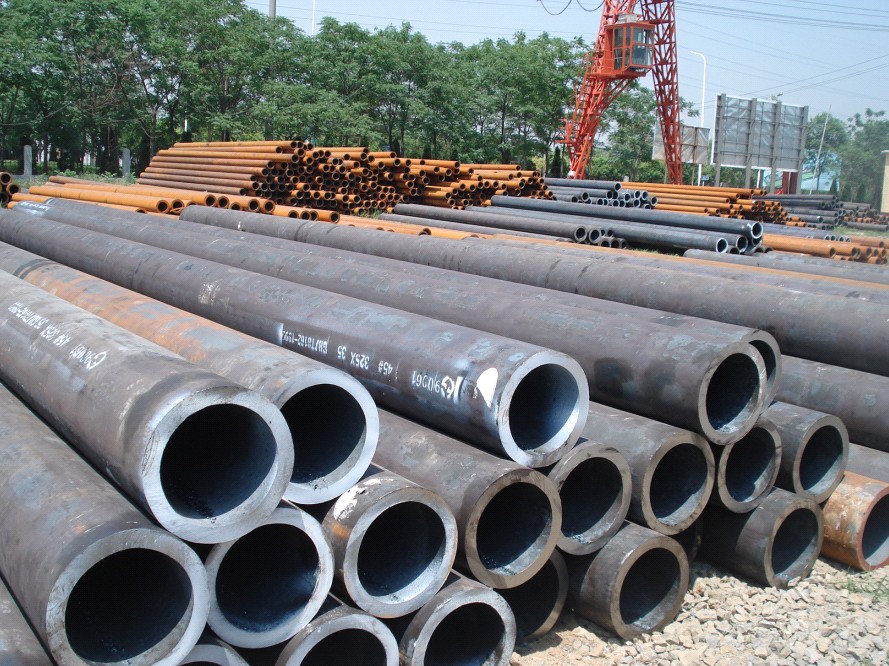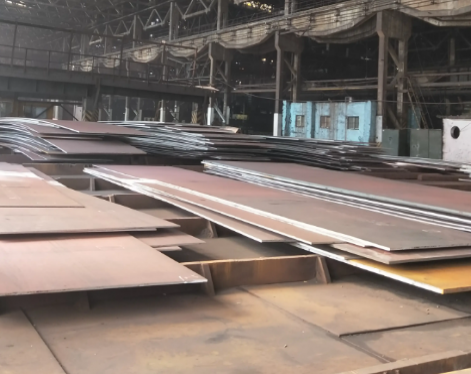Passivation of seamless tubes refers to the process of metal oxidation by strong oxidants or electrochemical methods to make the surface into an inactive state, that is, passivation.It is a method of converting the surface of the steel pipe into a state that is not easily oxidized and delaying the corrosion rate of the metal.
The process of passivation treatment of seamless tube
Depending on the material of the seamless pipe and the severity of the scale, it can be diluted with the original solution or diluted with water at a ratio of 1:1 to 4; ferrite, martensite and austenitic stainless steel with low nickel content can be diluted before use. Austenitic stainless steel with high nickel content (such as 304, 321, 316, 316L, etc.) is soaked in the original solution;Generally used at room temperature or heated to 50~60 degrees, soak for 3-20 minutes or longer (the specific time and temperature are determined by the user according to their own trial conditions),Until the surface dirt is completely removed, it becomes a uniform silver-white color, and a uniform and dense passivation film is formed. After the treatment is completed, take it out and rinse it with clean water. It is best to rinse it with alkaline water or lime water to neutralize it.
Note: The process of generating a trivalent or hexavalent chromium layer on its surface with a chromate solution and metal is called passivation, also known as chromating. It is mostly used for the treatment of aluminum, magnesium and its alloys. It can also form a chromed layer on steel, but it is rarely used alone, and is often used in conjunction with phosphating.In order to close the pores of the phosphating layer, the exposed steel in the phosphating layer is passivated, so as to inhibit the corrosion effect of the residual phosphating accelerator and further increase the protective ability. During passivation, potassium dichromate solution (2-4 grams per liter, sometimes 1-2 grams of phosphoric acid is added) is generally used, and it is immersed at 80-90 degrees Celsius for 2-3 minutes and taken out.

Precautions for Passivation of Seamless Tubes
(1) The passive surface naturally formed on the surface of stainless steel seamless pipe in air or other oxygen-containing environments is the fundamental guarantee for the corrosion resistance of seamless pipes. Before delivery, foreign objects such as surface oxide scale and iron ions are removed through special processes such as descaling, pickling, passivation or electropolishing to obtain a passive surface.
(2) The passive surface is essentially an extremely thin passivation film with a thickness of only 1~3mm, and its local contamination is the basic cause of corrosion of the seamless pipe.
(3) Great attention must be paid to the protection of the surface film during storage, transportation, use, and especially reprocessing.Strict precautions should be taken against rubbing, bundling or spreaders, contact with forklift brackets, storage anywhere, and sewage immersion.
(4) After the surface of the seamless steel pipe is contaminated during storage and transportation or reprocessing, it often needs to be purified again.In addition to the rational selection of the chemical composition of the purified liquid, the soaking time must be strictly controlled to prevent frost-like rough surfaces and even pitting corrosion caused by excessive pickling. Generally, 30 minutes should be enough, and it is not appropriate to soak in pickling or purified solution for tens of hours or even days.
(5) The mixed solution of nitric acid and hydrochloric acid is only suitable for descaling and pickling of solid solution austenitic or annealed ferritic stainless steel seamless pipes.
(6) 20%~50% nitric acid or 4%~10% citric acid solution can effectively clean the surface fouling except the thermal processing oxide scale and form an effective passivation film. Electrolytic polishing is a special method suitable for the production of high-gloss and passivated surfaces of ultra-clean surface steel pipes required by biochemical engineering and semiconductor industries.
(7) During the use of pickling and passivation solutions, the concentration of iron ions will increase and the acidity will decrease, which will lead to the early appearance of cloudy and pitting corrosion. Therefore, attention should be paid to the addition and renewal of sludge removal and acid solution during the repeated use of pickling purified solution.
(8) Ordinary mechanical grinding and polishing is difficult to completely remove the grinding debris, and it is only suitable for stainless steel welded pipes and structural decorations with sensitization tendency. When the requirements are higher, it should be chemically passivated after polishing.
(9) Stainless steel (pipe) should not be rusted by painting.
(10) For steel pipes with passivation requirements, casing lap butt joints should not be used.
The process of passivation treatment of seamless tube
Depending on the material of the seamless pipe and the severity of the scale, it can be diluted with the original solution or diluted with water at a ratio of 1:1 to 4; ferrite, martensite and austenitic stainless steel with low nickel content can be diluted before use. Austenitic stainless steel with high nickel content (such as 304, 321, 316, 316L, etc.) is soaked in the original solution;Generally used at room temperature or heated to 50~60 degrees, soak for 3-20 minutes or longer (the specific time and temperature are determined by the user according to their own trial conditions),Until the surface dirt is completely removed, it becomes a uniform silver-white color, and a uniform and dense passivation film is formed. After the treatment is completed, take it out and rinse it with clean water. It is best to rinse it with alkaline water or lime water to neutralize it.
Note: The process of generating a trivalent or hexavalent chromium layer on its surface with a chromate solution and metal is called passivation, also known as chromating. It is mostly used for the treatment of aluminum, magnesium and its alloys. It can also form a chromed layer on steel, but it is rarely used alone, and is often used in conjunction with phosphating.In order to close the pores of the phosphating layer, the exposed steel in the phosphating layer is passivated, so as to inhibit the corrosion effect of the residual phosphating accelerator and further increase the protective ability. During passivation, potassium dichromate solution (2-4 grams per liter, sometimes 1-2 grams of phosphoric acid is added) is generally used, and it is immersed at 80-90 degrees Celsius for 2-3 minutes and taken out.

Precautions for Passivation of Seamless Tubes
(1) The passive surface naturally formed on the surface of stainless steel seamless pipe in air or other oxygen-containing environments is the fundamental guarantee for the corrosion resistance of seamless pipes. Before delivery, foreign objects such as surface oxide scale and iron ions are removed through special processes such as descaling, pickling, passivation or electropolishing to obtain a passive surface.
(2) The passive surface is essentially an extremely thin passivation film with a thickness of only 1~3mm, and its local contamination is the basic cause of corrosion of the seamless pipe.
(3) Great attention must be paid to the protection of the surface film during storage, transportation, use, and especially reprocessing.Strict precautions should be taken against rubbing, bundling or spreaders, contact with forklift brackets, storage anywhere, and sewage immersion.
(4) After the surface of the seamless steel pipe is contaminated during storage and transportation or reprocessing, it often needs to be purified again.In addition to the rational selection of the chemical composition of the purified liquid, the soaking time must be strictly controlled to prevent frost-like rough surfaces and even pitting corrosion caused by excessive pickling. Generally, 30 minutes should be enough, and it is not appropriate to soak in pickling or purified solution for tens of hours or even days.
(5) The mixed solution of nitric acid and hydrochloric acid is only suitable for descaling and pickling of solid solution austenitic or annealed ferritic stainless steel seamless pipes.
(6) 20%~50% nitric acid or 4%~10% citric acid solution can effectively clean the surface fouling except the thermal processing oxide scale and form an effective passivation film. Electrolytic polishing is a special method suitable for the production of high-gloss and passivated surfaces of ultra-clean surface steel pipes required by biochemical engineering and semiconductor industries.
(7) During the use of pickling and passivation solutions, the concentration of iron ions will increase and the acidity will decrease, which will lead to the early appearance of cloudy and pitting corrosion. Therefore, attention should be paid to the addition and renewal of sludge removal and acid solution during the repeated use of pickling purified solution.
(8) Ordinary mechanical grinding and polishing is difficult to completely remove the grinding debris, and it is only suitable for stainless steel welded pipes and structural decorations with sensitization tendency. When the requirements are higher, it should be chemically passivated after polishing.
(9) Stainless steel (pipe) should not be rusted by painting.
(10) For steel pipes with passivation requirements, casing lap butt joints should not be used.









